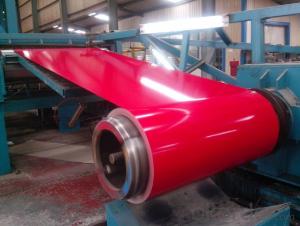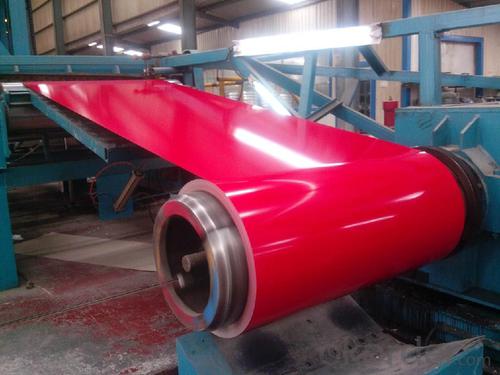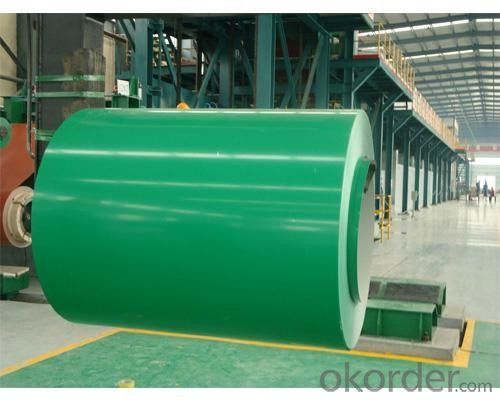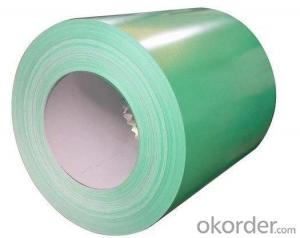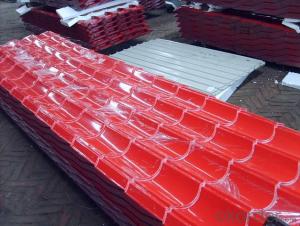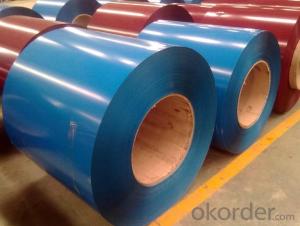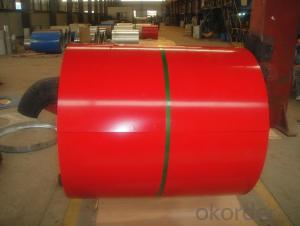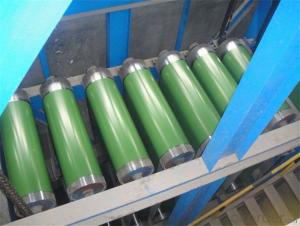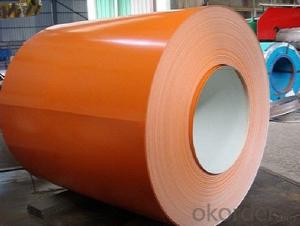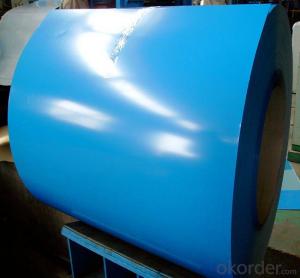Prepainted Aluminum Zinc rolled Coil For Construction
- Loading Port:
- Shanghai
- Payment Terms:
- TT OR LC
- Min Order Qty:
- 25 m.t.
- Supply Capability:
- 30000 m.t./month
OKorder Service Pledge
OKorder Financial Service
You Might Also Like
Structure of Aluminum Zinc Rolled Coil

Description of Aluminum Zinc Rolled Coil
Aluminum zinc coils is a kind of coated steel coil/sheet. With the cold rolled steel of different strength and thickness as substrate, it is produced through applying Al-Zn coat on both faces by hot dip process. In its coating, Al accounts for about 55%, Si 1.6%, while the remaining is Zn. Aluminum zinc coils enjoys both the physical protective feature and durability of Al and the electrochemical protective property of Zn. And its surface has bright silver color and regular embossed-like figure, which are highly decorative.
Main Feature of Aluminum Zinc Rolled Coil for Construction Roof
1.Corrosion resistance: It mainly depends on the aluminum protection. When the zinc being worn, the aluminum will form a dense layer of aluminum oxide, resist corrosion material to prevent further corrosion inside.
2. Heat resistance: Aluminum zinc alloy steel sheet has excellent heat resistance, can withstand high temperatures over 300 centigrade, and is similar with aluminized steel high temperature oxidation resistance. It often used in chimney pipes, ovens, fluorescent lighting device and the device cover.
3. Heat reflective: Galvanized steel plate heat-reflective high rate is twice as galvanized steel, often used to make insulation materials.
4. Economy: Because density of 55% AL-Zn is smaller than the density of Zn, so in the same weight and thickness of Galvanized zinc layer, aluminum-zinc steel plate is larger area more than 3% of galvanized steel sheet.
Applications of Aluminum Zinc Rolled Coil for Construction Roof
1. Construction and building: roofing; ventilating duct; handrail; partition panel;etc.
2. Electric appliance: refrigerator; washing machine; refrigerator; DVD;etc.
3.Transportation: oil tank; road sign; etc.
4.Agriculture:barn; etc.
5.Others:vending machine; game machine; etc.
Specifications of Prepainted Aluminum Zinc Rolled Coil for Construction
Product | Hot Dipped Galvanized Steel Coil / Galvalume /Aluzinc Steel coil |
Material Grade | SGCC / SGCH / DX51D+AZ, etc |
Thickness | 0.2-3.0mm |
Width | 600-1500mm |
Tolerance | Thickness: +/-0.02mm , Width:+/-2mm |
Zinc-coating | AZ40-150g/m2 |
Technique | Raw material: Hot rolled steel coil --> Cold rolled_>hot dipped galvalume |
Surface | Dried, Chromated, Unoiled |
Spangle | Regular spangle , small spangle, zero spangle |
ID | 508MM |
Coil weight | 3-6 tons |
Export package | Cardboard inner sleeves, Waterproof paper, galvanized steel covered and steel strip packed |
FAQ of Prepainted Aluminum Zinc Rolled Coil for Construction
We have organized several common questions for our clients,may help you sincerely:
1. What is the minimum order quantity ?
Our MOQ is 50mt for each size. And we will consider to give more discount if you make big order like 1000 tons and more. Further more, the more appropriate payment term your offer the better price we can provide.
2. How long can we receive the product after purchase?
Usually within thirty working days after receiving buyer’s advance payment or LC. We will arrange the factory manufacturing as soon as possible. The cargo readiness usually takes 15-25 days, but the shipment will depend on the vessel situation.
3. How to guarantee the quality of the products?
We have established the international advanced quality management system,every link from raw material to final product we have strict quality test;We resolutely put an end to unqualified products flowing into the market. At the same time, we will provide necessary follow-up service assurance.
- Q: How are steel coils used in the production of packaging machinery?
- Steel coils are used in the production of packaging machinery to create various components such as frames, supports, and structural parts. These coils are shaped, cut, and formed into specific designs to provide strength, durability, and stability to the machinery. Additionally, steel coils can be used to fabricate conveyor belts, rollers, and other moving parts, ensuring smooth operation and efficient packaging processes.
- Q: How many pounds can steel lift?
- Well, metal steel can lift an infinite amount of weight if necessary, BUT it can only withstand tensile PRESSURE up to a certain amount. That amount depends on what kind of steel you have; you can have low and high carbon steel, for example, here are some maximum tensile forces a lot of common steels can withstand: Coated Steel (Galvanized): 200-215 GPa Terne Coated Stainless Steel: 189 - 197 GPa Terne Coated Steel: 185-200 GPa AirMet100 High alloy steel: 193-203 GPa AF1410: 203 -213 GPa 17% Cobalt Steel: 199-209 GPa 36% Cobalt Steel: 199-209 GPa 6% Tungsten Steel: 218-229 GPa A-286: 201-211 GPa N-115: 201-211 GPa 250 Maraging Steel: 183 - 192 GPa 280 (300) Maraging Steel: 183-192 GPa And that's just Coated and High-alloy steels, I have yet to go through Cast Irons, Commercial-purity Iron, Low alloy steel, low carbon steel, medium alloy steel, medium carbon steel, stainless steels, tool steels, and very low carbon steels, and I'm not even sure if this is a complete list of the different types of steels in the world. TL;DR We need more information. EDIT: By pressure, I mean the negative tensile type of pressure. EDIT 2: At it's thinnest point, most supportive skeletal features will be able to support 132 pounds quite easily. However, if you want to make an effective light-weight strong skeleton, I would suggest using aluminium rather than steel.
- Q: How are steel coils used in the production of metal containers?
- Steel coils are used in the production of metal containers by being processed and formed into sheets, which are then shaped and welded to create the body and lids of the containers. The strength and durability of steel make it an ideal material for these containers, providing protection for goods during transportation and storage.
- Q: How are steel coils used in the manufacturing of HVAC ductwork?
- Steel coils are used in the manufacturing of HVAC ductwork as they provide strength and durability to the ducts. These coils are shaped and formed into the desired ductwork design, providing a rigid structure that can withstand the pressure and movement of air. The steel coils also ensure that the ductwork maintains its shape over time, preventing any deformation or collapse.
- Q: What are the dimensions of steel coils used in the agricultural structure industry?
- The dimensions of steel coils used in the agricultural structure industry can vary depending on the specific application and requirements. However, common dimensions range from 0.5mm to 3mm in thickness and 600mm to 1500mm in width.
- Q: How are steel coils used in the production of industrial equipment?
- Steel coils are used in the production of industrial equipment as their versatile and durable nature makes them ideal for fabricating various components such as frames, structures, panels, and parts. These coils are processed and shaped into the required size and shape, allowing manufacturers to create sturdy and reliable equipment that can withstand heavy use and harsh environments.
- Q: How can I owe a Pre-engineered Steel Building?
- You just have to do small efforts for owing a steel building: Firstly you have to finalize a steel building company for construction work. After finalizing the steel building company, the next step is the paperwork - the agreements and contracts. Some steel building companies may also ask for a verbal approval for the factories to get the work started.
- Q: What are the common methods of testing the strength of steel coils?
- Some common methods of testing the strength of steel coils include tensile testing, hardness testing, and bend testing. Tensile testing involves applying a pulling force to the coil until it breaks, measuring the maximum force it can withstand. Hardness testing determines the steel's resistance to indentation or scratching, providing an indication of its strength. Bend testing involves bending the coil to a specific angle and examining if it fractures or shows signs of deformation.
- Q: I need help my new stainless steel cookware is sticking ? My first meal was nasty!
- Food sticks to stainless steel. Gourmet cooks love it for that very reason. Without sticking, foods won't sear properly. For the rest of those cooks out there, nonstick is often an easier option. If you want to make a go of the stainless, here are some tricks of the trade.... a)always preheat the pan on low-medium b)never put cold food into a hot pan. It will stick worse.Leave cold food on counter for 15 minutes before it hits the pan. c)after preheating the pan, add oil, or an oil/butter combo d)for foods like eggs, potatos, grilled cheese, nonstick is your best friend. e) when you take food out of pan, immediately wipe the pan out with a kitchen towel. Keeps cleanup from being a nightmare. f) don't wash pans in sink while hot. They will warp. Stainless takes some getting used to. Hope this helps!
- Q: No. Not Stainless steel, I mean STEEL.Not a specific type, but STEEL.Thanks. xo
- Scott, there are 3 types of materials: elements, compounds, and mixtures. Compounds are covalently bonded elements. Compounds and elements are both considered 'pure' substances. Mixtures are not bonded in any fashion. So a steel mixture can have varying amounts of iron, carbon, silica,molybdenum, etc., giving the steel the desired properties (strength, rigidity, rust resistance, etc.).
Send your message to us
Prepainted Aluminum Zinc rolled Coil For Construction
- Loading Port:
- Shanghai
- Payment Terms:
- TT OR LC
- Min Order Qty:
- 25 m.t.
- Supply Capability:
- 30000 m.t./month
OKorder Service Pledge
OKorder Financial Service
Similar products
Hot products
Hot Searches
Related keywords
